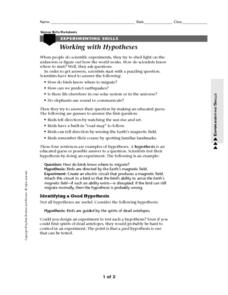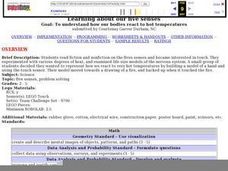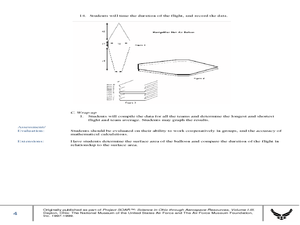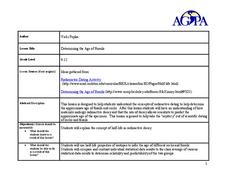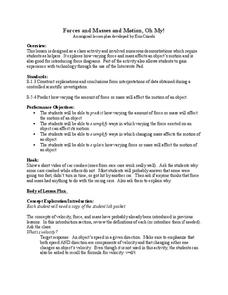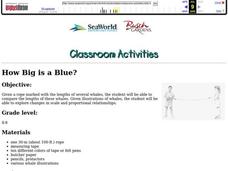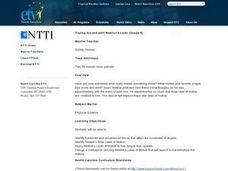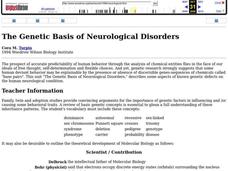Curated OER
Working With Hypotheses
In this science worksheet, students examine the topic in order to solidify knowledge covered in the curriculum using puzzles and creative games.
Curated OER
Bernoulli's Principle and Winged Flight
Third graders study Bernoulli's Principle and Winged Flight. In this biology lesson plan, 3rd graders to see how the decrease in air pressure which occurs when air is moving allows birds to fly.
Curated OER
Learning About Our Five Senses
Students study the sense of touch and various degrees of heat. They design a model that displays how the human hand reacts to heat using a touch sensor.
Curated OER
Seeping Stones
Students explore and experiment with oil traps in rocks. In this rocks lesson plan, students explore the porousness of different rocks and how the more porous a rock is, the more oil it can trap. Students also participate in a lab step...
Curated OER
Up, Up and Away with the Montgolfier Balloon
Students construct hot air balloons. In this science lesson, students assemble their own balloon using tissue paper and glue. They time the duration of the flight, record data and calculate team averages.
Curated OER
Is There Really Life on Mars?
Students examine the work of scientists and determine how they test their theories.
Curated OER
Insect Classification
Students compare and contrast the visible structures of three insects based on photographs. They differentiate characteristics of crane flies, ants, and wasps then create a simple classification system.
Curated OER
The Accuracy of Horoscopes
Students examine horoscopes over a months time and determine which horoscope source is the most accurate.
Curated OER
Point of View and Scientific Truth
High schoolers investigate the mystery of the "destructive force." They explore the concepts of natural phenomena. Students discuss the limited aspects of natural phenomena and the "whole truth" to generate new hypotheses that can be...
Curated OER
Creating The Virtual Model
High schoolers engage in a instructional activity that is about the concept of earthquake design. The instructional activity includes the integration of technology and how it can be used to create buildings and structures for...
Curated OER
Natural Selection
Learners practice calculating allele and genotype frequencies in the framework of a simple simulation using hard candy, calculators, and a worksheet. This lesson includes a three-page worksheet and an assessment question for conclusion.
Curated OER
One Square Foot
Students identify, describe, count, tally, and graph life found in one square foot of land.
Curated OER
Cosmic Collisions and Risk Assessment
In groups, students create their own scientific impact experiments using ordinary materials, and observe and measure results with a variety of impacting bodies and velocities.
Curated OER
Feedback and Flowcharts
Sixth graders explain what a negative feedback system is and they distinguish it from a positive feedback system. They describe examples of how negative feedback is used in both nature and technology. , Students define homeostasis, and...
Curated OER
Determining the Age of Fossils
High schoolers examine the concept of radioactive dating. In this radioactive dating instructional activity, students investigate how to determine the ages of fossils and rocks as they learn about half-life radioactive decay.
Curated OER
Forces and Masses and Motion, Oh My!
Students explore how varying force and mass effect the motion of an object. In this motion lesson students participate in a class activity and demonstrations.
Curated OER
Severe Weather - Deciding Where to Live
Students recognize the variety and frequency of severe weather occurrences. They research the type of severe weather that may occur in their area as well as determine the frequency of occurrence.
Curated OER
HOW BIG IS A BLUE?
Young scholars compare the lengths of whales using different lengths of rope. They illustrate one whale in life-size proportion.
Curated OER
Toying Around with Newton's Laws
Eighth graders identify balanced and unbalanced forces that affect the movement of objects and Newton's three Laws of Motion. Students also design a contraption utilizing Newton's Laws of Motion that will launch a marshmallow five meters.
Curated OER
Testing the Waters
Learners use test kits to measure the level of chlorine, iron, sulfide, and dissolved oxygen in tap (drinking) water and stream water. They post and evaluate the results of these water quality tests.
Curated OER
Putting Your Best Foot Forward
Third graders measure their feet and their parents' feet, record data on computer-generated graphs, and calculate and record mean, median, and mode.
Curated OER
The Genetic Basis of Neurological Disorders
Students explore neurological disorders. They examine the presence and absence of discernible genes. Students describe neruological diseases and draw faces of affected persons. They play a human neurology disorders learning game.
Curated OER
Leaf Patterns
First graders explore the existence of patterns in everyday items. In this science and math integrated instructional activity, 1st graders match leaves with a name word card and organize them into four patterns. This instructional...
Curated OER
A Leap of Space
Students explore how smaller systems exist within larger systems as they build a collage of their place in space! Invite the students to display their posters and talk about their systems and systems of systems.


